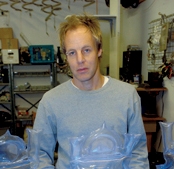|
Performing Arvo Pärt's "Fratres" in concert:nova Garden. Video by Charles Woodman (photo by David Cohen)
|
It was just another fanciful touch for
concert:nova, which has been dipping into the “fantastic” since its founding
in 2007.
Theme of the concert was light, at its
scarcest now with the Winter Solstice approaching, making it a
fitting tribute to the season of light.
Concert:nova, a dozen musicians from the
Cincinnati Symphony and Cincinnati Chamber Orchestras who take “nova” (new)
seriously by injecting new ideas and artistic disciplines into classical music
and performing in unconventional venues, explored darkness last year, with a
concert in the dark in the black box theater at the Contemporary Arts Center.
Monday evening in “concert:nova Garden,”
an un-renovated space on the ground floor of the Metaphor Building, the lights
were on -- and in some highly creative ways.
The program was exacting and mostly contemporary, including music by
George Crumb, Toru Takemitsu, Andre Jolivet, George Tsontakis and Arvo Pärt.

Visual artists Anthony Luensman and Charles
Woodman created video and lighting effects to complement and enhance the
musical experience.

The concert began with Gregorian chant. With blue light playing on the back wall, a choir
of 14 led by Ken Lam and Matthew Peattie sang “O Oriens,” an antiphon for December 21 (date of the Winter Solstice) and “Domine Deus virtutem.”
A bit of theater followed, with flutist
Randolph Bowman, cellist Theodore Nelson and pianist Julie Spangler donning black
masks for Crumb’s 1971 “Vox Balaenae (“Voice of the Whale”) for Three Masked
Players." Crumb specified masks to try to
distance the work from the human realm and amplified instruments to help evoke
the undersea world. Videos of sea life by
Woodman projected onto a large screen adjacent to the players accompanied the performance.
Crumb was inspired to write “Vox Balaenae” by
the singing of the humpback whale. Bowman
played the leviathan’s role by playing and singing into his flute (often
simultaneously) and by whistling, flutter-tonguing and tapping the keys. This created an uncanny effect , especially
in the prologue for whale solo, entitled “Vocalise for the beginning of time.” Bowman, Nelson and Spangler fleshed out the
watery soundscape on their instruments and on crotales (small, tuned cymbals).
Structurally, it’s a theme and variations framed
by the prologue and a touching epilogue, “Sea Nocturne for the end of time.” The five variations are named for Earth’s geologic
eras like “Archeozoic,” “Proterozoic,” etc.
It delivered a message. Bowman’s
introductory “Vocalise” was interrupted by sharp piano chords followed by
ominous plucking by Nelson reminiscent of the opening bars of Strauss’ “Also
Sprach Zarathustra” symbolic of man’s intrusion on the marine environment (the
screen is dark in the epilogue).
All three players had lots to do: Spangler on “prepared” piano (objects placed
in or on the piano to alter the sound) where she moved between the keyboard and
the strings, which she strummed for breathtaking, whooshing sounds. Nelson introduced the dream-like theme using
fingered harmonics.
There was little chance of the visuals overwhelming
the music here. Woodman, professor of
fine arts at the University of Cincinnati College-Conservatory of Music, provided gorgeous, sensual images from Monterey
Aquarium in California, including oozy white and pink jellyfish and schools of silvery
fish against a deep blue background.
Japanese composer Toru Takemitsu’s 1981 “Rain
Tree” for percussion trio was another highlight. Brady Harrison and Jeff Luft on marimbas and
crotales and CSO principal timpanist Patrick Schleker on vibraphone and
crotales evoked novelist Kenzaburo Oe’s 1980 “Clever Rain Tree” about a tree
whose leaves collect water, to be released when it no longer rains. They played in front of a shimmering wall of glass
prisms suspended over a black curtain with a video of sunlight on water
projecting through them.
Communication among the three players was
remarkable as they negotiated the work’s complex rhythms while conveying its
sense of a steady, “dripping” pulse.
Bowman
starred again after intermission in Jolivet’s 1941 “Chant de Linos” for flute,
harp and string trio. Extremely
difficult – deliberately so, having been commissioned for a flute competition at
the Paris Conservatoire – it caused no problems for Bowman. The CSO’s principal flutist is not only a
daunting technician, but a master of tone production (no one I know plays the flute more sweetly).
“Chant de Linos” refers to an ancient Greek funeral
lament. (Linos ended badly. By various accounts, he was either torn apart
by dogs at birth or, having grown up to become a great musician, was killed by his
inept student Hercules or the jealous god Apollo.) The work contains dance rhythms in 7/8 time,
slow elegiac passages and sharp outcries of grief. Bowman, harpist Gillian Benet Sella,
violinist Anna Reider, violist Heidi Yenney and cellist Nelson conveyed its contrasting emotions
vividly. Woodman’s accompanying video, of
landscapes shot at different angles that gradually came together to form mirror
images, was engrossing.
Tsontakis’ octet “Gymnopedies” invites
visual imagery by its very titles: “Magical,” “Glistening,” “Cascades” and “Bratty.” Performed by violinist Tatiana Berman,
violist Yenney, cellist Nelson, flutist Bowman, clarinetist Ixi Chen, French
hornist Matt Annin, harpist Sella, pianist Spangler and percussionist Schleker
and led by CSO assistant conductor Lam, the music spoke for itself, with vivid musical imagery for each movement (upward surges in "Glistening," for example). The colored light projected onto the wall – blue for “Cascades,” red for “Bratty” -- was mostly
superfluous, though it made a ravishing image reflected on Sella’s golden harp.
Pärt’s “Fratres” was performed by Berman, Reider, Yenney and Nelson in a version for string quartet. Written in Pärt’s ethereal, tintinnabuli style, it comprises a sequence of chords sounded initially by harmonics and
repeated in a strictly ordered descent over an open-fifth drone in the second
violin and pizzicato punctuation by the cello.
The music takes on warmth and vibrato as it descends into mid-range before tapering off at the end. The first violin
and viola are directed to re-tune their lowest strings downward, necessitating
adjustment of bowing and fingering to match the altered timbre and pitch of the
instruments.
The quartet met these not insignificant demands
admirably, including Reider on her ten-minute, Zen-like drone. Part’s sense of spiritual passage -- of a
unity attained -- was conveyed with skill and refinement.
To close the program, the singers returned
for a repeat of “O Oriens” and, in the luminous spirit of the holiday season,
Thomas Tallis’ “O Nata Lux” (“Light Born of Light”).
The concert drew a crowd of 200, causing an
unexpected delay in the starting hour and standing-room-only for some
listeners. There were also occasional
(minor) electrical problems.
Nevertheless, you wanted to cheer for the volunteer-driven
group, which handled tickets, tech support, logistics and complimentary food
and drink (from Via Vite, Coffee Emporium and Madisono's gelato) with energy and good
humor.
C:n’s next program will be in February, the exact
date to be announced. Dubbed “The
Essential Mahler,” the concert will celebrate the 150th anniversary
of Gustav Mahler’s birth and will feature chamber ensemble versions of his “Das
Lied von der Erde” and Symphony No. 4.